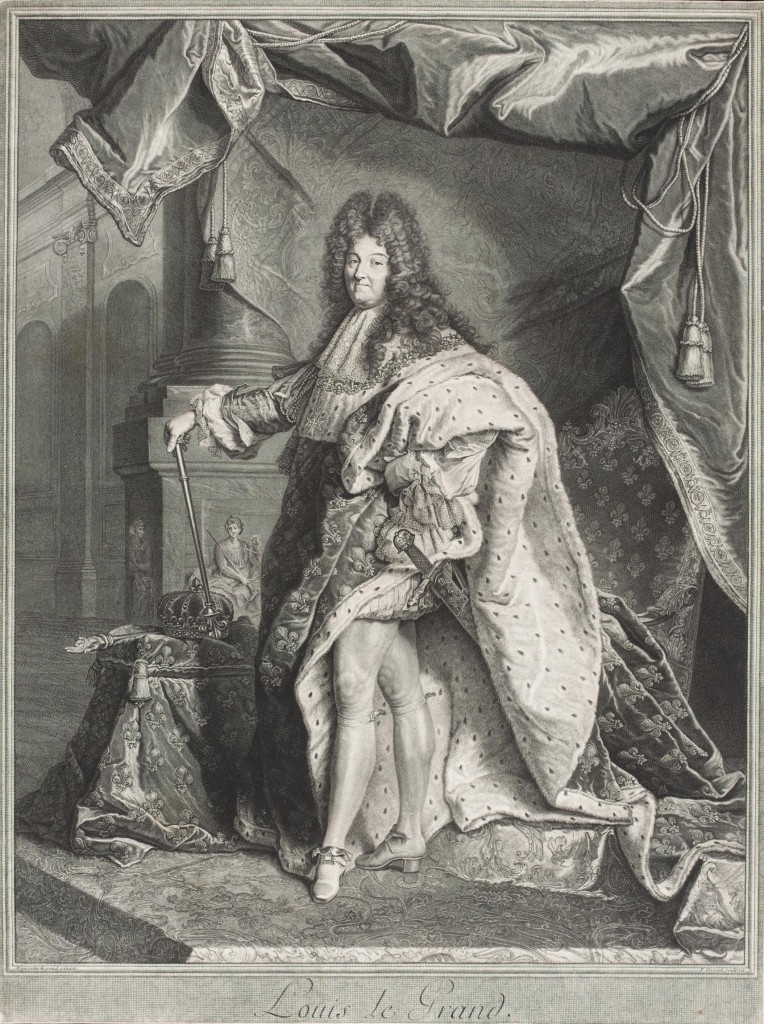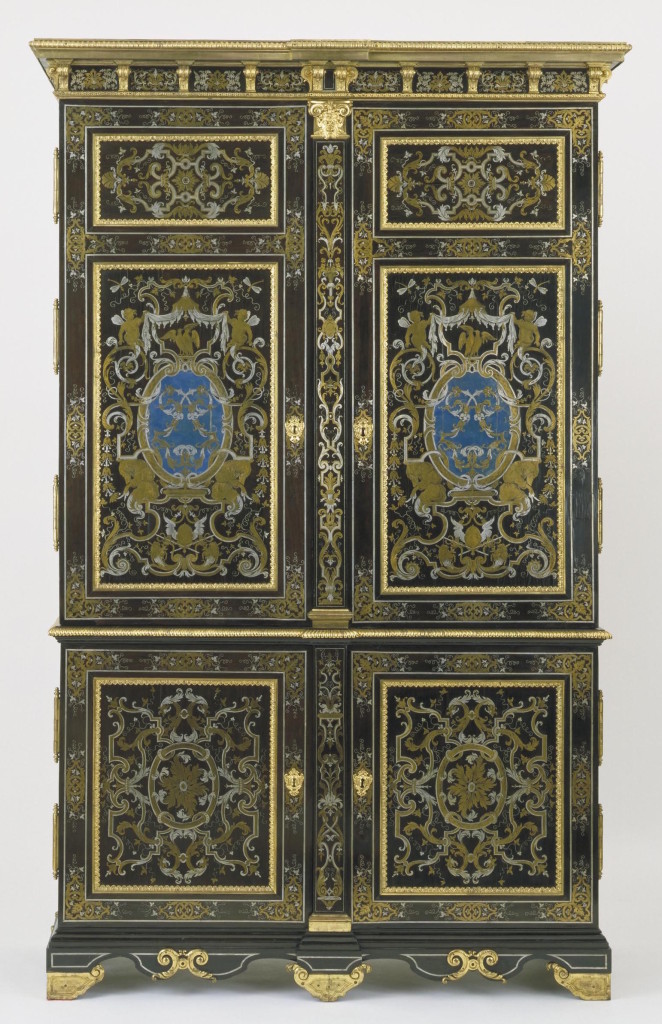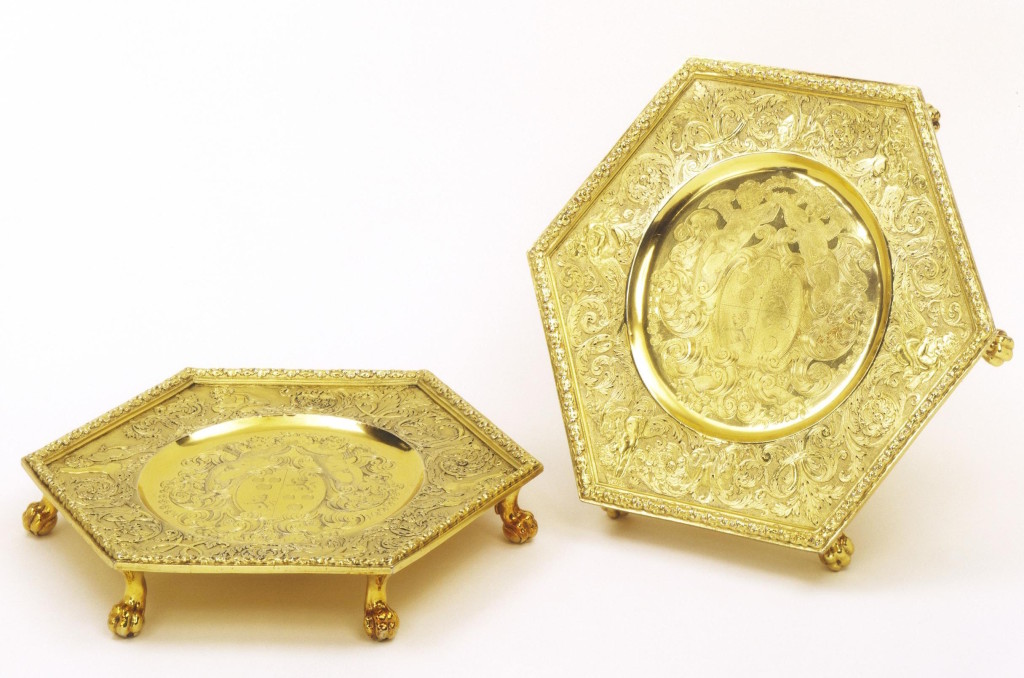
Pierre Drevet after Hyacinthe Rigaud, ‘Louis le Grand’, 1712, engraving. © Victoria and Albert Museum, London.
This has of course been quite the year for Louis XIV, with a number of events and exhibitions staged across many months to mark the tercentenary of the close of “the great” monarch’s reign. On the 5th of December the V&A held a symposium – Lambrequins and Luxury: Ornament in the time of Louis XIV and Beyond – sponsored by the Gilbert Trust for the Arts and the Institut Français Du Royaume-Uni, to explore the artistic and ornamental legacy of this fecund period for the fine and decorative arts, with a panel of speakers drawn from the interconnected worlds of the museum, academia and the auction house. The panel was truly international in character, pleasingly reflecting the king’s own latitudinous outlook, which, as Philip Mansel explained in a lecture he gave for the Society of Court Studies just two evenings before, was surprising in its geographical reach and perspicacity.
There were lambrequins and luxury aplenty in four sessions devoted to, respectively: the arts directly connected with the person of Louis XIV; the career and output of one of the period’s key players, André-Charles Boulle; the style and interiors of Louis XIV’s court, and those it influenced; and the dissemination of the Louis XIV, or more broadly, baroque style through ornament prints and the work of itinerant craftsmen.
![French workshop after designs by Charles Le Brun, Detail of 'Air' [allegorical portrait of Louis XIV as Air from a set depicting the four elements] , 1683-c.1690, linen canvas hanging embroidered in wools and silks. © Victoria and Albert Museum, London.](https://www.journal18.org/wp-content/uploads/Lebrun_hanging_detail.jpg)
French workshop after designs by Charles Le Brun, Detail of ‘Air’ [allegorical portrait of Louis XIV as Air from a set depicting the four elements] , 1683-c.1690, linen canvas hanging embroidered in wools and silks. © Victoria and Albert Museum, London.

Unknown maker, boulle marquetry armoire, c. 1700, ebony veneers, engraved pewter , brass and horn marquetry on an oak carcase, bequeathed by Mr John Jones, London. © Victoria and Albert Museum, London.
Mia Jackson opened the second session with a fascinating presentation on the large collection of prints and drawings amassed by cabinetmaker to the king, André-Charles Boulle, shown by Mia to have been a “prints omnivore.” In a compelling case study Carolyn Sargentson unlocked an elaborate mystery armoire in the Boulle style from the V&A’s collections, effortlessly fusing tenets of both curatorial and academic research. Marcus Rädecke provided the all-important auction house perspective, tracing in detail the changing market fortunes of Boulle furniture over two and a half centuries and elucidating these peaks and troughs by connecting them to important political and social events.
Daniëlle Kisluk Grosheide evoked all the curiosity and spectacle of formal audiences at Versailles under Louis XIV in the first paper of the third session; this highly topical research will be showcased in detail in a forthcoming exhibition that will open at the Met in May 2017, Visitors to Versailles, 1682-1789. Frédéric Dassas then discussed the intellectual and curatorial challenges posed by a project to conserve and re-create the interiors of the lost hôtel Le Bas de Montargis. Thrilling before and after photographs of the conservation and reassembling of the hôtel’s panels were testament to the success of this undertaking, the fruits of which can now be enjoyed in all their splendor in the Louvre’s new decorative arts galleries. Similarly visionary is Jonathan Gration’s doctoral project to reconstruct digitally the vanished interiors of Boughton, commonly known as the English Versailles. This Jonathan has done, in as intricate detail as possible, drawing on archival sources, and artfully reimagined, down to the ornamental potted trees known to have lined the estate’s walks.
In the fourth and final session Femke Speelberg gave a comprehensive overview of the evolution and status of the ornament print in seventeenth-century France, the sources that in most cases either prompted or recorded many of the objects examined throughout the day’s papers. Femke traced their antecedents back to the engraved ornament of the reign of François I. Adriana Turpin shed new light on the life and œuvre of Cornelius Gole, a Huguenot cabinetmaker in the service of Queen Mary, providing tantalizing glimpses of little-known yet exceptional pieces in private collections. And finally, Tessa Murdoch teased out the diverse range of sources for an exquisite set of waiters executed for the Courtenay family of Powderham Castle.

Benjamin Pyne, set of four waiters from Powderham Castle, 1698-1699, silver gilt dishes, cast and engraved. © Victoria and Albert Museum, London.
This packed programme of stimulating papers and discussion was capped off by a concert of French and British Baroque music, performed by Opera Lyrica in the intimate yet appropriately stately surroundings of the Little Oratory. The arts of Louis XIV are far too numerous and complex to be exhaustively investigated and précised in one day, but the research presented in this symposium capably highlighted the key stylistic tenets, spread, lure and continuing legacy of the works that issue from the monarch’s long reign.
Sarah Grant is Curator of Prints at the Victoria and Albert Museum
Cite this note as: Sarah Grant, “Ornamenting Louis XIV”, Journal18 (2015), https://www.journal18.org/204
Licence: CC BY-NC
